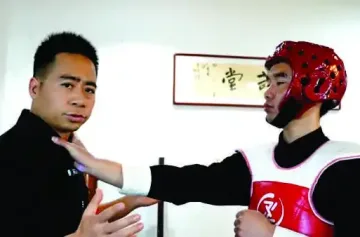Introduction
In this digital age, more and more parents are focusing on their children’s all-round development. Martial arts, especially Wing Chun, is becoming a new choice for many families to cultivate their children. Wing Chun not only exercises the body but also nurtures the mind, making it a suitable traditional martial art for young people to practice. This article will delve into the various benefits, learning techniques, and considerations for young people learning Wing Chun, hoping to provide valuable reference for parents interested in having their children learn this martial art.
Benefits of Wing Chun for Young People
1. Self-Defense: Cultivating Safety Awareness
In today’s society, the ability to protect oneself is increasingly important. Wing Chun, as a highly practical martial art, can effectively help children deal with potentially dangerous situations. By learning Wing Chun, children not only master basic self-defense skills but, more importantly, develop a keen sense of safety awareness. This awareness will accompany them as they grow, becoming an important safeguard in life.
2. Enhancing Physical Fitness: Building a Healthy Body and Mind
Wing Chun training involves coordinated movements of the entire body’s muscle groups, comprehensively enhancing young people’s physical fitness. Through systematic physical training, children’s strength, endurance, and overall physical qualities will be significantly improved. A healthy physique is an important asset in life, and early martial arts training undoubtedly lays a solid foundation for children’s future health.
3. Improving Coordination and Reaction Ability: Shaping Agile Skills
Wing Chun emphasizes both offense and defense, requiring practitioners to pay attention to defense while attacking. This characteristic makes Wing Chun training significantly improve children’s body coordination and reaction speed. In daily life, the enhancement of these abilities will make children more agile and able to cope with unexpected situations with ease.
4. Improving Posture: Preventing Modern Ailments
In this era of prevalent electronic devices, more and more children are developing modern ailments such as cervical spine problems and myopia due to long-term poor posture. Wing Chun practice requires maintaining correct body posture, and long-term persistence can effectively improve posture, preventing problems like hunchback and myopia. This not only benefits children’s healthy growth but also cultivates their lifelong habit of maintaining good posture.
5. Cultivating Virtues: Forging Martial Ethics and Character
Martial arts are not only physical exercise but also spiritual cultivation. Through learning Wing Chun, children can develop many excellent qualities such as diligence, perseverance, respect for teachers, honesty, integrity, and focus. These qualities will accompany children throughout their lives, becoming an important part of their character, and will have a profound impact on their future study and work.

Techniques for Young People Learning Wing Chun
To achieve good results in learning Wing Chun, mastering the correct learning techniques is crucial. Here are some important learning points to note:
1. Solid Basics
Basic skills are the foundation of martial arts learning, and Wing Chun is no exception. Here are some important basic exercises:
Turning Stance: This is the basic stance method in Wing Chun, which can practice the flexibility and stability of footwork. Beginners should practice every day, gradually increasing the duration.
Advancing and Retreating Stance: These two movements train the control of the center of gravity and the coordination of movement. Correct advancing and retreating stances lay the foundation for movement in actual combat.
Snake Hand: As one of the basic hand techniques in Wing Chun, Snake Hand can enhance hand flexibility. Beginners should practice slowly to ensure accurate movements.
Chain Punches: This is a basic attacking technique in Wing Chun, emphasizing the combination of speed and power. When practicing, pay attention to power transmission and body coordination.
Chopstick Drill: This seemingly simple exercise can effectively strengthen finger and wrist power, which is very important for improving the practical combat ability of Wing Chun.
2. Systematic Form Practice
Wing Chun has its specific form system, such as Siu Nim Tao, Chum Kiu, and Biu Jee. It’s very important to practice the learned forms every day, which not only ensures standardized movements but also helps form muscle memory. Beginners should learn various forms progressively under the guidance of a master, and continuously review and deepen them in daily practice.
3. Correct Breathing and Relaxation
Wing Chun emphasizes natural breathing. During practice, the body should be in a moderately tense state, rather than completely relaxed. Correct breathing methods can improve practice effectiveness and enhance physical fitness. Beginners can consciously adjust their breathing while practicing basic movements, gradually forming a natural and coordinated breathing rhythm.
4. Focus on Practical Application
Wing Chun is a very practical martial art, so attention should be paid to the practical application of techniques during learning. You can check and improve your skills through practice with partners. However, it should be noted that combat practice should be conducted under the guidance of an experienced master to ensure safety.
5. Maintain Patience and Perseverance
Learning martial arts is a long-term process that requires great patience and perseverance. Young people learning Wing Chun may encounter bottleneck periods, which is when persistent practice is even more necessary. Parents should provide appropriate encouragement and support to help children get through difficult times.

Considerations for Learning Wing Chun
While enjoying the many benefits of Wing Chun, we also need to pay attention to some issues to ensure the safety and effectiveness of learning:
1. Choose the Appropriate Age to Start
Experts suggest that 6 to 7 years old is the ideal age to start learning Wing Chun. Children at this age have already developed to a certain extent and can adapt to the intensity of martial arts training. Starting training too early may put unnecessary strain on children’s bodies.
2. Avoid Early High-Intensity Training
Although Wing Chun has obvious effects on improving physical fitness, high-intensity training should not be carried out too early. Children under 4 years old are not suitable for learning Wing Chun as their bodies and minds are not yet ready. Even when they reach the appropriate age for learning, progress should be gradual to avoid putting too much pressure on the body.
3. Emphasize Movement Standardization
In the practice process, the standardization of movements is crucial. Each movement should be practiced slowly according to the correct method, avoiding neglecting movement quality due to seeking speed or quantity. Parents can encourage children to review more at home, but must ensure the accuracy of movements.
4. Avoid the Pitfall of Mirror Practice
Many beginners like to practice in front of a mirror, thinking that this can better correct their movements. However, this approach may lead to a loss of spatial sense, affecting the cultivation of practical combat ability. It is recommended to practice in an open space to feel the movement of the body in three-dimensional space.
5. Safety First
Although Wing Chun is a self-defense technique, safety still needs to be paid attention to during practice. Especially when conducting partner practice or combat simulation, it is necessary to control the strength to avoid causing harm to oneself or others. Parents should always pay attention to their children’s practice situation and communicate with the coach promptly if any problems are found.
6. Balance Learning with Other Activities
Although learning Wing Chun is important, it should not affect children’s studies and other interests. Parents need to help children arrange their time reasonably and find a balance point between martial arts training and other activities.
7. Respect Tradition, Inherit Culture
Wing Chun is not only a martial art but also an important part of traditional Chinese culture. In the learning process, children should be made to understand the history and cultural connotation of Wing Chun, cultivating their respect and love for traditional culture.
Conclusion
Learning Wing Chun not only strengthens the body but also cultivates good character and habits in young people. Through systematic training, children can achieve comprehensive improvement in physical fitness, self-protection ability, psychological quality, and many other aspects. However, the learning process requires patience and perseverance, as well as the support and encouragement of parents.
Let us work together to create a healthy, confident, and positive growth environment for our children. May Wing Chun, this ancient and wisdom-filled martial art, bloom more brilliantly in the new era, contributing to the all-round development of children and young people!







